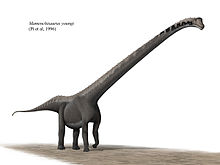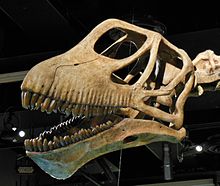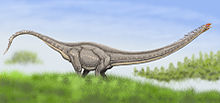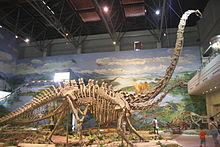
Mamenchisaurus
About this schools Wikipedia selection
SOS Children have produced a selection of wikipedia articles for schools since 2005. See http://www.soschildren.org/sponsor-a-child to find out about child sponsorship.
| Mamenchisaurus Temporal range: Late Jurassic, 160–145Ma |
|
|---|---|
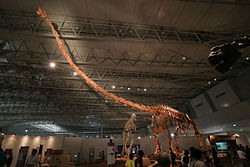 |
|
| Mounted skeleton of M. sinocanadorum, Japan | |
| Scientific classification |
|
| Kingdom: | Animalia |
| Phylum: | Chordata |
| Class: | Reptilia |
| Order: | Saurischia |
| Clade: | †Sauropodomorpha |
| Clade: | †Sauropoda |
| Family: | †Mamenchisauridae |
| Genus: | †Mamenchisaurus Young, 1954 |
| Type species | |
| †Mamenchisaurus constructus Young, 1954 |
|
| Species | |
|
|
Mamenchisaurus (pron.: / m ɑː ˈ m ʌ n tʃ i ˈ s ɔr ə s / mah-MUN-chi-SAWR-əs, or spelling pronunciation / m ə ˌ m ɛ n tʃ i ˈ s ɔr ə s /) is a sauropod dinosaur genus including several species, known for their remarkably long necks which made up half the total body length. It is known from numerous species which ranged in time from 160 to 145 million years ago, from the Oxfordian to Tithonian ages of the late Jurassic Period of China. It may include the species Mamemchisaurus sinocanadorum, one of the largest known dinosaurs and the largest dinosaur known from a nearly complete skeleton.
Discoveries
Mamenchisaurus was first discovered in 1952 on the construction site of the Yitang Highway in Sichuan, China. The partial skeleton fossil was then studied, and named Mamenchisaurus constructus in 1954, by the renowned Chinese paleontologist Professor C. C. Young. The type specimen had an incomplete neck with 14 vertebra preserved and none of these were complete . M. constructus was estimated at 13 m (43 ft) long.
In 1972, a second species of Mamenchisaurus was discovered (M. hochuanensis) with a neck that reached up to 9.3 m (31 ft) in length. This species had a complete neck preserved which contained 19 vertebrae. In 1994, Sauroposeidon was discovered in the United States, with a neck estimated to be between 10.5 and 11.5 meters (34.5–37.5 feet) long, though its neck did not exceed that of the previously known Supersaurus, with a neck reaching 13–14 meters (42.5–46 feet).
In 1993, M. sinocanadorum was described; this species possessed the longest cervical rib of any described sauropod dinosaur, measuring 4.1 m (13.5 ft). This is longer than the longest Sauroposeidon cervical rib, which measures 3.42 m (11.2 ft). Additional remains attributed to this species but not yet formally described comprise almost the entire skeleton. Mounted specimens of M. sinocanadorum measure 35 metres (115 ft) in length with a nearly 17 metres (56 ft) long neck, making it the largest dinosaur known from good skeletal remains and one of the largest known dinosaurs.
In 2001, another M.hochuanensis specimen was described. It had skull, pectoral girdle and forelimb material preserved, all of which were missing from the holotype. It was also found with four fused tail vertebra, which have expanded neural arches and taller neural spines, that belong at the tip of the tail. It’s thought that these could be a weapon, such as a tail club, or a sensory organ. Other Chinese sauropods, Shunosaurus and Omeisaurus, are also known to have had ’tail clubs’ but they differ in shape to that of M.hochuanensis.
Naming
Mamenchisaurus means 'Mamenchi lizard', from the Chinese Pinyin mǎ (马 'horse') and mén (门 'gate'), while chi is a transliteration of xī (溪 'stream' or 'brook'), combined with the suffix -saurus (from Greek sauros meaning 'lizard').
It was intended to name the reptile after the place where its fossil was first found — a construction site next to the Mǎmíngxī (马鸣溪) Ferry Crossing by the Jinsha River (金沙江, the westernmost major headwater stream of the Yangtze River), near Yibin (宜宾) in Sichuan Province of China. However, due to an accentual mix-up by Young, the location name Mǎmíngxī (马鸣溪 'horse-neighing brook') was mistaken as Mǎménxī (马门溪 'horse-gate brook').
The fact that the first Mamenchisaurus fossil was found as the result of construction work led to Young's naming the type species as Mamenchisaurus constructus.
Species
- M. anyuensis He, Yang, Cai, Li & Liu, 1996. Approximately 21 meters (69 ft) in length. Known from both the Suining Formation and Penglaizhen Formation.
- M. constructus Young, 1954: ( Type species) The holotype specimen, represented by a partial skeleton and was 13 m (43 ft) long.
- ?M. fuxiensis Hou, Zhao & Chu, 1976: Partial skeleton, include parts of a skull. It was originally named Zigongosaurus, and may be a different genus.
- M. hochuanensis Young & Zhao, 1972: Four partial skeletons. Known from Shaximiao Formation and 22 m (72 ft) in length.
- M. jingyanensis Zhang, Li & Zeng, 1998. Known from Shaximiao Formation and estimated between 20 to 26 metres (66 to 85 ft) in length.
- M. sinocanadorum D. Russell & Zheng, 1993: Partial skull, isolated bones (type), referred, nearly complete skeleton. Known from the upper part of the Shishugou Formation (about 160 Ma ago), it may include one of the largest complete dinosaurs specimens known, measuring 35 metres (115 ft) in length.
- M. youngi Pi, Ouyang & Ye, 1996: Mamenchisaurus youngi (pronunciation YOUNG-eye) was unearthed in Xinmin County, Zigong City in Sichuan Province, China, in 1989. The species was named in honour of Young. It was a very complete and articulated specimen presvering all the vertebra from the head up until the 8th tail vertebra. It had 18 neck vertebra. At 16 meters (52 ft) long with a 6.5-meter (21 ft) neck, is relatively small among various species of Mamenchisaurus.
